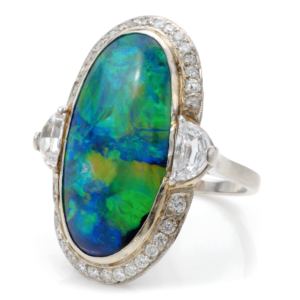ALVR Blog: Opal-Essence

Opal is the birthstone for October, but we think this gem should be celebrated year round! Opals are truly a wonder to behold. A hydrous variety of silicon dioxide, it’s composed of tiny silica spheres bonded together with silica and water. Known for their brilliant flashes of color, this optical phenomena is the result how the silica spheres are layered within the stone, scattering the light in different directions.
Opals come in a brilliant range of colors, including orange, yellow, red, green, blue, and purple. White opals are the most common. Found in Hungary, white opals feature flashes of color against a white, almost translucent, ground. Black opal, one of the more prized forms that is mined in Australia, exhibits a play of color against a dark ground. Fire opal, so named for its bright yellow, orange, or red background color, is primarily found in Mexico and Ethiopia.
Opals have been revered for centuries. Because the colors of other gems can be found in opals, the Romans considered opal to be the most precious and powerful of all gemstones. In the Middle Ages, opals were believed to bring good luck by embodying the virtues of all gemstones.
Although admired since ancient times, the reputation of this luminescent gem darkened in the nineteenth century. In this period, opal lost its luster thanks to the publication of Sir Walter Scott’s 1829 novel, Anne of Geierstein. In the novel, the character Lady Hermione wears an opal with supernatural powers that changes color according to her mood. After the opal is sprinkled with holy water, it loses its color, leaving her ill, and the following day, reduced to ashes. Scott’s decision to use the gemstone as a supernatural life source must have been inspired by the flashes of color seen on an opal when it’s exposed to light. Misunderstanding of this optical phenomenon, along with the stone’s delicate nature, inspired awe and superstition.
Unfortunately, Scott’s artistic license had consequences for the opal market, rendering this once lucky stone to be quite the opposite. In fact, within one year of its publication, sales of opals decreased by nearly 50% and remained low for the next twenty years. Superstition arose from a misunderstanding of opal’s delicate nature. They rank 5.5 to 6.5 out of 10 on Mohs scale of hardness, making opal more fragile than other stones. Because of their high water content, they’re particularly sensitive to sudden climate changes. While Sir Walter Scott exaggerated this sensitivity, it should be noted that the stone can crack under dry conditions, or rapid changes of temperature.
Like Sir Walter Scott, nineteenth-century American poet Hannah Flagg Gould was inspired by opal’s lifelike qualities. In her 1845 poem “The Opal,” she describes the stone as “the gem with the burning heart,” referring to the luminous spot that changes position in the light. Her interpretation is more optimistic than Scott’s, implying that the stone is imbued with holy light:
Gem with the burning heart,
That, as a living soul,
Pervading Every Part,
Gives beauty to the whole,
What angel’s hand thy bosom lit,
With the bright spark enkindling it.
Published in 1845, the poem illustrates opal regaining favor by mid-century. However, at the time of the Crimean War, old superstitions returned briefly when the stone was blamed for giving soldiers bad luck. In subsequent decades, attitudes warmed as more opal deposits were discovered, rekindling the opal market. This was particularly so later in the century when, in 1877, black opal was discovered in New South Wales, Australia. Queen Victoria also played a significant role in restoring opal’s reputation. She loved to wear them and was known to give them as gifts. She gifted opal jewelry to each of her five daughters as wedding presents and loved to give opal rings to many of her friends.
In this age opals are revered once again. So long as it’s taken care of, the burning heart endures.


745 Fifth Avenue, 4th Floor, NYC 10151
1.212.752.1727
Terms of Sale | Terms of Use | Privacy Policy
© A La Vieille Russie | Site by 22.